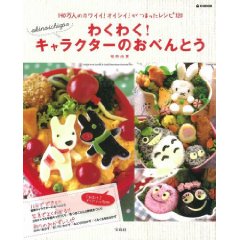 Although the school year starts in April in Japan, September still means back-to-school time after the summer school holidays, so there are a slew of new bento books and such coming out. Two of top Japanese charaben/kyaraben (character bento) artists and bento bloggers have published things in print this month, which you might be interested in taking a look at if you are into this genre of bentos. (Yes they are all in Japanese, but they both are guaranteed to have big beautiful full color photos!)
Although the school year starts in April in Japan, September still means back-to-school time after the summer school holidays, so there are a slew of new bento books and such coming out. Two of top Japanese charaben/kyaraben (character bento) artists and bento bloggers have published things in print this month, which you might be interested in taking a look at if you are into this genre of bentos. (Yes they are all in Japanese, but they both are guaranteed to have big beautiful full color photos!)
First up is a mook (large magazine format book) from the lady who blogs under the nickname akinoichigo, titled akinoichigo's Fun Fun! Character Bento (akinoichigoのわくわく! キャラクターのお弁当). Her work featured prominently in the Face Food book. I've always admired her elaborate, very cute yet refined bentos, especially her wonderful sense of color, which really sets her apart. Being a mook, it's not that expensive either - only 980yen base price from Amazon Japan. Ms. akinoichigo also conducts bento seminars, so I'm assuming she's a good teacher too!
The other publication is a supplement to the October 2008 issue of Ohayo Okusan (おはよう奥さん, which translates to Good Morning Mrs. Housewife), a women's magazine aimed at well, housewives. (It's sort of like Good Housekeeping in the U.S.) Anyway, the supplement, titled Asa tsukuranai! obentou (Bentos not made in the morning!) is all about bento lunches that are composed of make-ahead components that are just assembled in the morning. It's authored by the bento artist asami122 (her blog post about it is here, where she has a photo of the supplement too), and includes some quick tips for charaben/kyaraben too. Ms. asami122 is the creator of the traditional kimono-clad Hello Kitty bento mentioned here. The attention to detail in her bentos is simply mind boggling. She too teaches charaben bento skills in small classes. The October issue of Ohayo Okusan isn't available directly from Amazon Japan at the moment, but most Japanese bookstores such as Kinokuniya should carry it. One issue of Ohayo Okusan is only 540 yen, so it's a bargain if you can find it!